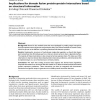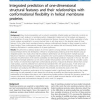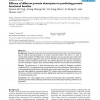258 search results - page 12 / 52 » A Framework for Improving Protein Structure Predictions by T... |
BMCBI
2004
13 years 8 months ago
2004
Background: Several in silico methods exist that were developed to predict protein interactions from the copious amount of genomic and proteomic data. One of these methods is Doma...
BMCBI
2008
13 years 8 months ago
2008
Background: Protein secondary structure prediction method based on probabilistic models such as hidden Markov model (HMM) appeals to many because it provides meaningful informatio...
BMCBI
2010
13 years 8 months ago
2010
Background: Many structural properties such as solvent accessibility, dihedral angles and helix-helix contacts can be assigned to each residue in a membrane protein. Independent s...
BMCBI
2007
13 years 8 months ago
2007
Background: Sequence-derived structural and physicochemical descriptors have frequently been used in machine learning prediction of protein functional families, thus there is a ne...
ARTMED
2004
13 years 8 months ago
2004
Successful secondary structure predictions provide a starting point for direct tertiary structure modelling, and also can significantly improve sequence analysis and sequence-stru...



